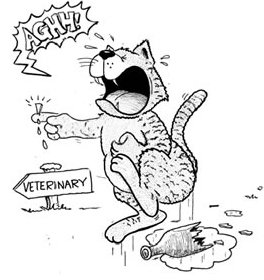Top 8 Signs that you Need to take your Cat to the Veterinarian Immediately
Top 8 Signs that you Need to take your Cat to the Veterinarian Immediately
By Arnold Plotnick

Would you know a cat emergency if you saw one? I discussed feline first aid for cats and kittens (what to do in a cat emergency), but now I want to point out signs that should cause the pet owner to say, "This is a cat emergency! I need to get my cat to the veterinarian immediately."
It’s amazing the variations that I’ve seen among my clients in terms of how often they bring their cat to the veterinarian. I have some clients who bring their cat in if they hear one sneeze, or find one puddle of vomit. I’ve had others who hold off on bringing their kitty to the clinic until the cat is on death’s doorstep. (Fortunately, my current clients never wait that long. However, years ago when I used to practice on cats and dogs, it was a different story.)
I personally believe that cats should be examined by a veterinarian a minimum of twice a year. In adult cats, six months is the equivalent of about two years in human years. A lot can happen to a cat in six months. If not every six months, then certainly at least once a year.
There are scenarios, however, when a cat should be seen RIGHT AWAY. I’m sure there are some people who would perhaps add a few other signs to my list, however, I tried to narrow the list down to a realistic number of signs without getting too carried away. Here are the top 8 signs that you need to take your cat to the veterinarian immediately.
1. Straining in the litterbox (especially male cats) – Some cats will go into their litter box, posture themselves to eliminate, and then just sit there and strain. It can be difficult for some cat owners to tell if their cat is posturing to urinate vs. defecate.

If a cat is posturing to defecate and is straining and straining, is this an emergency? Probably not. But it should be seen as soon as possible, i.e. the next day, because this can be uncomfortable for the cat, and the longer the constipation persists, the more difficult it can be to relieve the problem later. Is straining to urinate an emergency? In a female cat, probably not. Straining to urinate can be a sign of a urinary tract infection, bladder stone, or bladder inflammation (cystitis), however, and this also can be very uncomfortable for the cat, but it’s not life threatening. In a male cat, however, it’s a different story. When a male cat is straining to urinate, he too can be afflicted with a urinary tract infection, a bladder stone, or just an inflamed bladder (cystitis). Male cats, however, can become OBSTRUCTED. This almost never happens in females. In males, this is a life-threatening condition. A male cat with an inflamed bladder may go in and out of the box, and every time he goes, he deposits just a drop or two of urine. The few drops of urine get absorbed into the cat litter, where it’s undetectable. A male cat with a urinary obstruction will go into the litter box and strain to urinate, and no urine is produced. It can be difficult or impossible for a cat owner to tell if the cat is completely obstructed and isn’t producing any urine at all, or if he’s got an inflamed bladder and is depositing little drops of urine onto the litter the moment they accumulate in his bladder. You need to err on the cautious side and BRING HIM TO THE VET IMMEDIATELY. Failure to promptly relieve the obstruction can result in kidney damage, severe metabolic derangements, and ultimately death unless the obstruction is relieved.
2. Labored breathing – Congestion from an upper respiratory infection is a common problem in cats, and cats with stuffy noses and sinuses can sometimes have audible breathing noises, especially when sleeping. (Put simply, they snore.) This is not an emergency. Some cats with inflammation in their lungs, either from an infection, or from asthma, will cough. They will hunker down, extend their neck, and make a raspy sound. This, too, is not an emergency, but should be evaluated by a vet, of course. A cat with LABORED breathing, however, is a different situation. If your cat, at rest, seems to be showing increased respiratory effort, this needs to be addressed immediately. A cat’s breathing motion – the excursions of the chest - should be barely noticeable. If you can easily see your cat inhaling and exhaling in an exaggerated fashion, as if he just ran around the block a few times, this is definitely not normal and is a cause for concern. Often, there will be a little abdominal press at the end of each breath. Again, this is not normal. He needs to be examined immediately. Unlike dogs, cats should NEVER breathe with their mouth open. Open-mouth breathing means that you take your cat to the vet NOW. If it’s after hours, find the nearest 24-hour veterinary emergency clinic. The likely causes of this include pulmonary edema – fluid within the lung tissue – which is a common sign of heart failure, or pleural effusion – fluid between the lungs and the chest wall. This fluid prevents the lungs from fully expanding. This fluid may need to be removed immediately. Removal of the fluid not only will give the cat some relief, but analysis of the fluid often helps in making the diagnosis.
3. Seizures – Whenever a cat seizures, you can basically break down the cause as either being neurologic, or being non-neurologic. Non-neurologic causes of seizures include things like liver disease (if the liver is sick and cannot detoxify the blood, the toxins in the blood can affect the brain and cause seizures), low blood calcium, and low blood sugar. Low blood sugar is much more likely to cause seizures in dogs. Cats with low blood sugar tend to act spacey and uncoordinated, as if you might imagine what a cat would look like if it were drunk. But occasionally, low blood sugar can cause seizures in cats. Neurologic causes of seizures include things like brain tumors and epilepsy. If your cat is a known diabetic and experiences a seizure, low blood sugar due to an overdose of insulin has to be considered, and you should rub some honey or corn syrup onto the gums (once the seizure subsides, to avoid getting accidentally bitten), and the cat should stop seizuring and come around to relatively normal mentation. The cat should then be taken to the veterinarian immediately. One single seizure, however, may not necessarily be an emergency. Some cats will have one seizure, will recover uneventfully, and never have another one. If a cat has one seizure, recovers pretty promptly, and seems okay, it may not need to go to the vet right this minute, however, an appointment should be set up so that the cat can be examined and some bloodwork performed to rule out the non neurologic causes. More than one seizure in a short period of time, or persistent seizures, however, needs to be addressed IMMEDIATELY.
 <- cutest vomit ever!
<- cutest vomit ever!
4. Persistent vomiting - Every cat vomits occasionally. Most of the time there is a harmless explanation for it, such as a sudden change in diet, eating too fast, or hairballs. In some instances, however, vomiting can be a serious sign of illness. When cats vomit, the cause is either a problem in the gastrointestinal system or a problem elsewhere in the body. For example, cats can vomit from a gastrointestinal disorder such as food allergy or inflammatory bowel disease. They can also vomit from systemic disorders that have nothing to do with the gastrointestinal system, such as kidney disease; if the kidneys can’t remove toxins from the bloodstream the toxins accumulate, leading to nausea and vomiting. Because vomiting has so many potential causes, diagnosing the reason for the vomiting can be challenging. An acute bout of vomiting in a cat that seems normal otherwise is seldom a cause for concern, and can be treated symptomatically at home by withholding food for a few hours and then gradually re-introducing the diet. Cats that have vomited multiple times in one day or several days in a row may need to be examined by your veterinarian. Kittens and young cats are not very discreet about what they put in their mouths. Middle aged and mature cats who should know better will also occasionally eat things they shouldn’t. Ingestion of a foreign body can cause an obstruction that prevents food from passing. Cats will vomit food persistently, and may even vomit water. Cats can get seriously dehydrated as a result, and the longer the foreign body remains lodged in the intestinal tract, the more potential damage to the gastrointestinal tract can occur. Regardless of the cause, persistent vomiting can cause dehydration and dangerous electrolyte imbalances and should be addressed promptly.
5. Bleeding – Every now and then, a cat owner will notice some blood in their cat’s urine, or in the stool, or will discover little spots of blood on the furniture or the bedspread, indicating that their kitty might be ill. This kind of bleeding is not an emergency, however, it should be investigated by your vet as soon as practical. Blood in the urine can be a sign of a painful bladder stone. Significant bleeding from a visible wound, especially if the blood is pulsating from any part of the body, warrants IMMEDIATE veterinary attention. Cats can get dangerously anemic from blood loss and can go into shock. This is so obvious that maybe I should have left this off the list, but I’m including it anyway.
6. Staggering or stumbling – There are many possible reasons for a cat to stagger or stumble. Weakness from anemia, or from a metabolic problem (excessively low potassium, too low blood sugar), or a neuromuscular problem, or a vestibular problem (infection or inflammation involving the vestibular system, which is the part of the nervous system that control balance). This list just scratches the surface. Some of the causes are relatively benign. Some of the causes, however, can be very serious. There’s no way for a cat owner to know. You have to err on the cautious side and bring the cat to the vet IMMEDIATELY.
7. Non weight-bearing lameness – Every now and then, cats will pull a muscle or sprain a joint. Usually, this manifests as a mild limp. In an older cat, arthritis is certainly a common cause for stiffness and occasional limping. If you see your cat limping, ideally, the cat should be evaluated by your vet reasonably promptly. However, waiting for a day or two and observing to see whether it is getting progressively better is a reasonable thing to do. If the limp persists after another day or two, obviously the cat should be seen. Non weight bearing lameness, however, should not wait. A cat that cannot bear weight on a limb and is walking on three legs should not be observed for a few days to see if it improves. Non-weight bearing lameness is often a sign of a fracture, dislocation, or torn ligament. These are painful injuries that need to be addressed right away. With fractures, the sooner they are repaired, the better the chance that proper healing and restoration of normal function will occur.
8. Any symptom that persists for 48 hours or longer, or gets noticeably worse quickly – I guess this is a catch-all selection, but it holds true. A cat is allowed to cough a few times during the day, with the owner observing to see if it’s a brief episode that disappears as quickly as it came on. If, however, the cat coughs all day, and the next day it does the same, then the cat needs to be examined right away. Two or three episodes of vomiting in one day may require careful observation by the owner. If the next day, the cat is eating and the vomiting has stopped, or the cat has only vomited once, it’s okay to watch for one more day and see if the vomiting has resolved. But if the cat vomits a few times on day 1, and on day 2 the vomiting persists or gets worse, the cat should be seen. The same goes for diarrhea, poor appetite, sneezing, limping, runny eyes, snotty nose… any symptom that persists for a second day, or dramatically gets worse later that day or the next day, should be evaluated by a veterinarian promptly, i.e. the next available appointment at the vet’s office.
Hopefully this list will help pet owners realize that while cats seem pretty self-sufficient (indeed, many of their issues seem to resolve on their own without much intervention on our part), there are some issues require more than just benign observation.
------
Article By Arnold Plotnick. Posted with permission.
The normal body temperature of a cat is between 100.5 ° and 102.5 °F. A cat is sick if its temperature goes below 100 ° or above 103 °F.